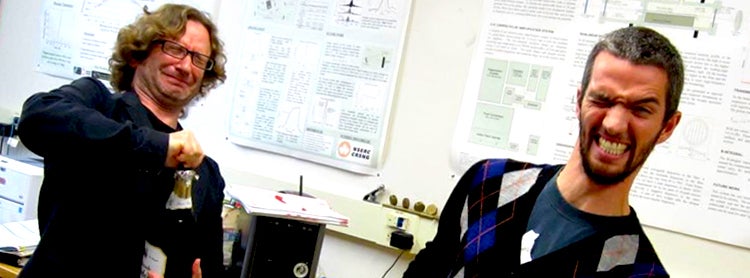Student Interaction: Joseph Sanderson’s Group-Based Learning
 |
| Physicist Joseph Sanderson pries open a celebratory bottle as his graduate student, Benji Wales, anticipates the Big Bang. |
Written by Victoria Faraci, Special Projects (Teaching Stories), CTE.
Whether it’s popping champagne after a Master’s defense, or travelling to Tokyo to further their research, Joseph Sanderson and his graduate student, Benji Wales, make an unstoppable pair. Most notably, though, it’s when they’re teaching PHYS 111, a first-year physics class for bioscience students, that this amazing duo is at their best.
Dr. Joseph Sanderson has been teaching at the University of Waterloo since 2001. Working in the Physics and Astronomy department, Sanderson is known not only for his passion for physics but also for his enthusiastic use of group work within his classrooms.
With the goal of “maximizing learning through group work and peer instruction, while minimizing student dissatisfaction,” Sanderson’s courses are models of active learning environments. His convictions about the efficacy of group work are rooted in a deeper philosophy about contemporary education in general. He says that in a technological age where students can watch lectures online, what is the impetus to actually attend the educational institution? Answering his own hypothetical question, Sanderson asserts that it’s insufficient to suppose that what makes a university effective is only the interaction between students and instructors. Though he acknowledges that this is an important component, he adds that “maybe the more important thing is to have students learning together in an environment where they can interact.”
Interviewing Sanderson and Wales separately, it’s clear to see that their teaching philosophies are closely aligned. Both instructors guide their students to the correct solutions, but never take them there directly. Sanderson says that it is sometimes a challenge to let students work together without too much intervention, while at the same time encouraging them to feel like they can ask for help. It’s during tutorials, which Sanderson terms a “smaller more democratic classroom,” that the group work component of this course really comes alive.
As a tutorial leader, Wales makes a conscious effort to answer student questions by getting students to answer their own questions. For him, the most rewarding part of this method is to see students learning from one another. Wales surmises that, “in a room of 100 students and one expert, you can either try to communicate a concept one way to 100 students, or have a hundred ways communicated to one student.” Because of this, peer interaction has been an invaluable part of PHYS 111.
Tyler Begley, a student in this course, commented that after explaining the physical concepts in class, Sanderson gave practical examples for the students to answer. Begley says that the “real teaching” began when someone got a question wrong because Sanderson would go to great lengths to explain to the class why it was incorrect.
Moving away from forms of conventional, lecture-style teaching is an unmistakable trademark of Sanderson’s teaching philosophy. Being enthusiastic about the subject helps, he asserts, finding inspiration in the fundamentals of his discipline while pursuing evidence-based methods. Wales also speaks fondly of his supervisor, saying his teaching style is a departure from traditional forms of teaching. However, this departure is what encourages students to self-achieve because they end up taking responsibility for their own learning. This is something Wales hopes will permeate into more classrooms. Speaking to the future of university teaching, Wales says, “I think we will see more classrooms in the same voice as Joe, and education will be better for it.”
On that note, Sanderson reiterates his belief that “group work is, in some sense, the future of university existence.” His philosophy suggests that peer-to-peer interaction plays a vital role in both teaching and learning at the university level.
Read more Teaching Stories
Tip sheets
CTE has developed more than 100 Teaching Tips. Each one is a succinct document that conveys useful ideas and practical methods for effective teaching. Some of the Teaching Tips that are relevant to the strategies mentioned in this Teaching Story include the following: